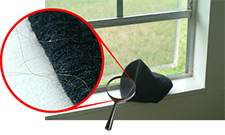Home | Glossary | Resources | Help | Contact Us | Course Map
Archival Notice
This is an archive page that is no longer being updated. It may contain outdated information and links may no longer function as originally intended.
The best evidence occurs when a victim's or suspect's DNA is found where it is not supposed to be or where information does not support contact having ever occurred between the victim and suspect.
Example: A breaking and entering occurred in a residential area; near the point of forced entry, a knit cap was found. The homeowners confirmed the knit cap was not theirs. No perspiration or other cellular transfer was found along the inside rim of the cap, which appeared new. However, several head hairs were recovered from inside. One of the hairs had a root with tissue attached and a DNA profile was obtained. This DNA profile may be used to identify the perpetrator.
Additional Online Courses
- What Every First Responding Officer Should Know About DNA Evidence
- Collecting DNA Evidence at Property Crime Scenes
- DNA – A Prosecutor’s Practice Notebook
- Crime Scene and DNA Basics
- Laboratory Safety Programs
- DNA Amplification
- Population Genetics and Statistics
- Non-STR DNA Markers: SNPs, Y-STRs, LCN and mtDNA
- Firearms Examiner Training
- Forensic DNA Education for Law Enforcement Decisionmakers
- What Every Investigator and Evidence Technician Should Know About DNA Evidence
- Principles of Forensic DNA for Officers of the Court
- Law 101: Legal Guide for the Forensic Expert
- Laboratory Orientation and Testing of Body Fluids and Tissues
- DNA Extraction and Quantitation
- STR Data Analysis and Interpretation
- Communication Skills, Report Writing, and Courtroom Testimony
- Español for Law Enforcement
- Amplified DNA Product Separation for Forensic Analysts


